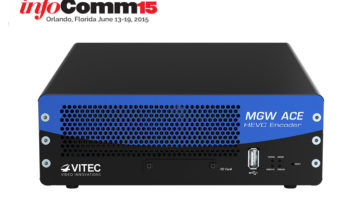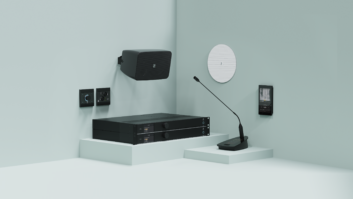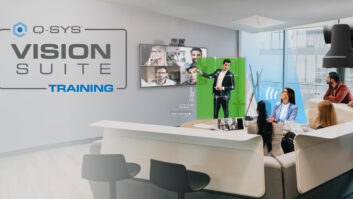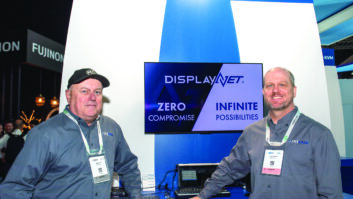Scaling and switching technology has advanced significantly in recent years. Steve Montgomery looks at how it is continuing to develop to meet user requirements.
[Pic: TV One’s CORIOmaster powers nine 60in and two 42in plasma walls and two large LED module displays for KSL TV, an NBC affiliate in Salt Lake City]
The video scaler has been with us for many years, serving an important role in altering the resolution of a video image from the native resolution of the source to match that of the display device, and in so doing enhancing the quality of the image for display. Its origins stem from the broadcast industry, where it began life as a tool to change video formats for use in other regions using different broadcast standards – between PAL and NTSC for example.
These ‘standards converters’ were expensive and complex and carried out the function with large, densely populated hardware boards which shrank in size and cost as new electronic devices, including FPGAs, were deployed.
As the size and cost fell, the technology was adopted by the commercial presentation industry and high-end home cinema markets, where upscaling (or simpler line-doubling) devices were produced to increase the resolution of standard-definition TV for display on analogue projectors capable of showing far more picture lines.
However, they were costly, difficult to set up and had significant processing delay which meant that pictures became mis-timed with audio resulting in ‘lip-sync’ problems and unnatural cinema experiences.
In due course the technology improved through better software and hardware techniques, to the point that scalers became popular and beneficial to many market sectors. In many cases they were essential peripherals to early generation flatpanel displays. The display’s own on-board scaling capability, if it existed at all, was generally of poor quality and introduced visual artifacts.
With the relatively recent emergence of full high-definition broadcast and displays containing higher- quality internal scalers, offboard scalers are no longer as necessary. Although as Jed Deame, VP of marketing for RGB Spectrum, points out: “The cost constraints of the price-competitive TV market means that manufacturers will try to consolidate components wherever they can. This means that the processing power available for internal scaling is limited and the quality suffers. Larger, more expensive monitors can justify better, more complex processors and achieve somewhat higher quality, but still are much less capable than external scalers.”
However there is a growing demand for scalers. They are still necessary in dot-matrix displays, such as large LED walls to up- or down-convert the image for presentation where the layout is a non-standard size, and in irregular multi-screen displays. External processing devices can split and distribute a single image to screens in a complex display wall arrangement formed from a mixture of landscape and portrait display formats. This allows highly creative effects to be achieved by showing a single image over a split or disjointed multi-screen installation.
On the tiles
Many LCD display manufacturers now incorporate a tiling capability for the simple creation of videowalls. Each separate display can be programmed in its relevant position within the matrix and it will extract and display the picture area for that location. The electronics and software process necessary to perform this function are effective but do rely on basic, simple techniques to scale the portion of the image to full display size. This can result in visible artifacts and lack of sharpness across the screen, issues often encountered in retail point- of-sale applications and public displays.
@page_break@
[Pic: Eclipse Solutions AV was chosen for the first live audio/video communication event in Canada to provide a link from a Canadian school to the International Space Station.]
Superior techniques are available that can produce better image quality, but these require additional, more costly equipment to be used.
The ultimate solution, favoured in very high-quality installations, involves creating massively high-resolution images and splitting the image prior to display, generally at the time of production of the video. Each full-resolution section is stored and replayed from an individual player for each screen, with synchronisation to align and reform the complete image. Extremely high-resolution displays can be created over videowalls with 25 or more HD displays.
As the market developed, the scaling function was absorbed into the presentation switching devices used to control and route video sources to displays. Within this type of device the ability to change the resolution of an image is essential in the creation of Picture-in-Picture (PiP) effects and in showing multiple sources across a large videowall.
“In the control room environment, multi-input videowall displays need to be instantly controlled to present several picture windows at the same time, with the ability that each source can be scaled to any desired size and positioned as necessary on the wall in response to a critical situation,” explains Deame. “Integrated controllers manage this and provide scan conversion to cope with the wide variety of source devices onto the screen, including analogue and digital sources of all resolutions, as well as CCTV inputs and IP streams.”
The same requirement is necessary in commercial meeting rooms, lecture halls and boardrooms, where a visitor may arrive with a source of almost any format and a variety of different sources are likely to be used in a single event. “There is still a lot of analogue equipment out there in a variety of PC standard formats that are incompatible with the widescreen HD projector or display,” comments Tony McAhren, switcher product manager of TV One. “In addition, the variety of codecs, broadcast, 3D and online formats mean that different resolutions and frame rates are common and not all standards are adhered to rigorously. Users demand seamless, instant switching between sources.”
The advantage of an integrated firmware-based switching and scaling approach is that other functions can be performed within the device itself. McAhren continues: “The CORIOmaster system provides a host of effects including independent picture rotation on both inputs and outputs, edge blending, resizing, stored sequences and grouping of outputs for single or multiple display devices and walls.”
Switcher-scaler devices provide the glitch-free switching of disparate sources demanded by users. “While it is possible for analogue, DVI, HDMI and Displayport sources to be fed into a single projector or LCD screen and selected using the device’s own source selection control, this is highly problematical,” says Franck Facon of Analog Way.
“The screen will normally go blank or freeze during the changeover and very often an information message will appear advising the user of the new format and resolution, which is not conducive to prestige presentations and events. In addition, rental and staging companies demand more and more integrated systems in order to limit the cabling and spend less time to settle complex set-ups of shows. A single cable from the control and source equipment rack to the projector is far more manageable than several different types and can be achieved with a single extender pair, rather than multiple pairs, each handling a different format.”
Multiple choice
In a multi-input, multi-output presentation system most manufacturers agree that the optimum architecture to deliver best picture quality involves handling and distributing the incoming sources at their native resolution and providing scaling to the display format at the point of display. This not only prevents the possible adverse effects and artifacts that can be introduced through serial scaling, but enables the same source material to be used in different locations at different resolutions.
“The Enova system provides end-to-end switching of sources and distribution over twisted-pair cable to the endpoints where SmartScale technology automatically responds to the display’s declared EDID information. It also scales the video to the best video resolution and video parameters without manual set-up,” says Brian Davies, European technology and training director for AMX (UK). “This allows the creation of an all-in-one presentation switcher with the receiver-scaler moved out to the end display point. In systems with multiple format screens, for example in presentation breakout rooms with LCD screens rather than projectors, the image is kept in pristine format for all displays.”
This approach is verified by David Jones of Lightware: “Our MX range distributes content at its native resolution with no processing in order to minimise picture delay through the system. If scaling is required it is generally provided by additional devices at the display point, although with good EDID management and careful system design this is very rarely required, despite a culture of automatically including scaling within every system. The source will be forced to the correct resolution for the display. Where it is genuinely required is in handling legacy systems using old PCs and laptops, and for instant switching of sources. A receiver-scaler in one combination unit can be more cost effective than separate devices. This is something that we are introducing into the 25G product range to assist system integrators in their overall design.”
This architectural concept also provides major benefits in very high-resolution display systems providing future proofing, as Deame points out: “The distribution of electrical signals over twisted pair presents a trade-off between bandwidth and distance, so transmitting at a lower resolution followed by scaling can be done over longer distances than it is possible to transmit the higher-resolution image.
“For example, HDBaseT supports distances up to 100m at full 4K resolution but can be extended to 140m at HD resolution. Projector manufacturers are allowing for this with the recent introduction by several of them of integral HDBaseT receivers in their products. HDBaseT is a much more cost-effective solution than fibre at distances up to 100m or so.”
4K future
Deame continues: “Beyond that, 4K displays are beginning to emerge and will become more common in the future; that is, assuming this resolution is to be adopted widely. Currently we have limited ability to distribute full 4K resolution at 60 frames per second as there is no agreed standard or common usage that will set a de facto standard for 4Kp60 distribution to displays. The newer consumer displays have standardised on HDMI 1.4, which is limited to 4Kp30.
“Single cable 4Kp60 transport is possible over DisplayPort, but the 4K monitor manufacturers have not yet adopted that standard, in the hope that HDMI 2.0 will be ratified soon. In the meantime, professional displays rely on multiple cable solutions to achieve 4Kp60, including 4 x SDI, 4 x HDMI 1.3, 2 x dual link DVI, etc.”
Switcher-scaler devices have evolved rapidly over the past few years and greatly advanced the ability to handle, mix, add effects, distribute and display the highest-quality images over a wide area of applications.
This will continue even further, as Facon predicts: “Large events are operated on a global basis. The ability to receive and broadcast is a true reality for rental and staging companies and a necessary element in their operations. We are starting to see the integration of digital formats into their solutions of high-quality and high-resolution content using digital codecs such as H.264. This is set to increase and will become a significant factor within the evolution and growth of presentation switchers and processing devices as the digital display workflow converges between AV and IT systems. The next generation of products will be a true mix of both.”
www.amx.com
www.analogway.com
www.lightware.eu
www.magenta-research.com
www.rgb.com
www.tvone.com







